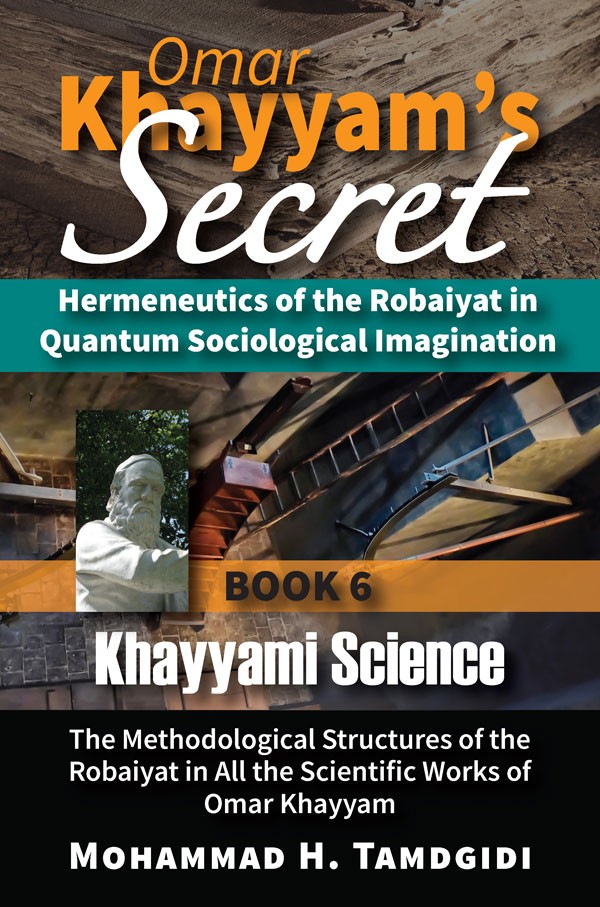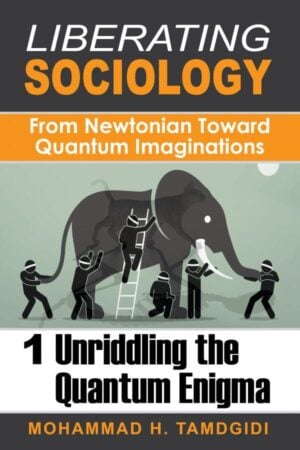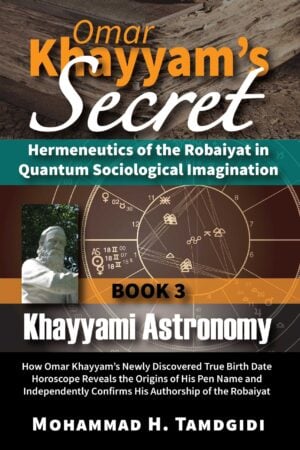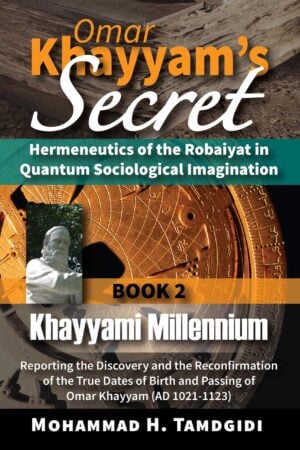Book Section: CHAPTER V—Omar Khayyam’s Treatise on the Explanation of Postulation Problems in Euclid’s Work: The Arabic Text, the Persian Translation by Jalaleddin Homaei, and Its New English Translation, Followed by Textual Analysis — by Mohammad H. Tamdgidi
$20.00
This essay titled “Omar Khayyam’s Treatise on the Explanation of Postulation Problems in Euclid’s Work: The Arabic Text, the Persian Translation by Jalaleddin Homaei, and Its New English Translation, Followed by Textual Analysis” is the fifth chapter of the book Khayyami Science: The Methodological Structures of the Robaiyat in All the Scientific Works of Omar Khayyam, which is the sixth volume of the twelve-book series Omar Khayyam’s Secret: Hermeneutics of the Robaiyat in Quantum Sociological Imagination, authored by Mohammad H. Tamdgidi.
Description
Abstract
This essay titled “Omar Khayyam’s Treatise on the Explanation of Postulation Problems in Euclid’s Work: The Arabic Text, the Persian Translation by Jalaleddin Homaei, and Its New English Translation, Followed by Textual Analysis” is the fifth chapter of the book Khayyami Science: The Methodological Structures of the Robaiyat in All the Scientific Works of Omar Khayyam, which is the sixth volume of the twelve-book series Omar Khayyam’s Secret: Hermeneutics of the Robaiyat in Quantum Sociological Imagination, authored by Mohammad H. Tamdgidi.
In this chapter, Tamdgidi offers an analysis of Omar Khayyam’s “Treatise on the Explanation of Postulation Problems in Euclid’s Work” (رسالة فى شرح ما اشكل من مصادرات كتاب اقليدس). For the purpose, after his introductory comments, the Arabic text of the manuscript along with its Persian translation published in 1967 in Iran by the late Jalaleddin Homaei (1900-1980) are presented, followed by his new English translation of the text based on Homaei’s Persian translation. He then present his analysis of the text.
Tamdgidi’s analysis of his treatise on Elements of Geometry (in short, Elements) by the Greek mathematician Euclid of Alexandria (c. 325-265 BC) in this chapter is intended to be hermeneutic in nature, not technically evaluative. In other words, his primary concern is not that of evaluating whether Khayyam successfully accomplished what he set out to do when solving this or that problem he found in Euclid’s work, but that of hermeneutically interpreting the meaning the effort had for him in the context of his worldview as a whole as expressed in his other writings. Applying Khayyam’s own three-steps whether (it exists), what (exists), and why (it exists) exploratory framework as introduced in his theological treatise “Resalat fi al-Kown wa al-Taklif” (“Treatise on the Created World and Worship Duty”), Tamdgidi aims to address questions surrounding the existence of the treatise itself, the basic meaning of what Khayyam advanced in his treatise, and why he wrote it, in the broader context of his scientific, philosophical, and theological works studied in this series so far and in anticipation of its forthcoming studies of Khayyam’s literary and poetic writings.
We know exactly when Khayyam completed in his own handwriting (as stated in the original copy the scribe of his treatise used to copy his own reaching us) his treatise on Euclid’s Elements. The scribe of the extant copy of the treatise widely used today notes that he was copying from Khayyam’s manuscript completed toward the end of Jumadi al-Avval of the year 470 LH, which would fall roughly on late December (of the Gregorian calendar) of the year AD 1070. He had even noted the place of its original completion, in the “book house” or library of a city whose name is unfortunately missing or rendered illegibly. The scribe was copying his own copy of it in the year 615 LH, about a lunar century after Khayyam’s passing in 517 LH (AD 1123).
Omar Khayyam’s treatise on Euclid’s work is above all a treatise on scientific method, using the critique of the postulation problems in Euclid’s Elements as an empirical site for the purpose. If his treatise in algebra advances Khayyam’s algebraic theory of existence by way of his classification of and solutions to cubic and lower algebraic equations, his treatise on Euclid is one in which he reveals in an applied way important aspects of his own scientific method.
In the first book of his treatise on Euclid, Khayyam advocates a consistent approach to the demonstration of scientific postulations and propositions. He critiques Euclid for not having followed his own systematic process of establishing the foundations of geometry, questioning why he did not offer a demonstration for the fifth postulate in Book I, when he has demonstrated elsewhere other propositions much more self-evident. When reviewing other thinkers’ efforts in proving the fifth postulate, such as that offered by al-Haytham, Khayyam continues to insist that principles of deductive method used in Elements should not be arbitrarily abandoned by introducing topics such as motion, rendering such solutions to be even more problematic than the fifth postulation they wish to rectify. For Khayyam, abiding by sound demonstration procedures in geometry is important because exploring the universal sciences of metaphysics in the First Philosophy, where spiritual topics are tackled, require consistent and sound logical procedures in advancing knowledge.
What is most interesting in Khayyam’s method as revealed by his discussion of how the subject matters of geometry and philosophy interrelate is his transdisciplinary approach to tackling problems in the geometry proper. Just because philosophical matters are not explicated in postulations and demonstrations of propositions in Euclid’s Elements, it does not mean they are irrelevant. On the contrary, he states that a reason Euclid went astray in not demonstrating the fifth postulate had to do with the assumptions he must have had drawn from the premises offered by “the philosopher” (Aristotle). And when offering his own demonstration of the fifth postulate, Khayyam himself lists several premises from philosophy that had to be taken for granted as self-evident by those trying to rectify Euclid’s shortcoming. And yet, when it came to suggesting how his alternative eight propositions should be inserted in Elements, Khayyam stated that the “philosophical material” he had engaged with can and should be omitted, since they belong to the philosophy proper. By way of such suggestions, Khayyam has left us with an excellent hermeneutic evidence for judging his text not by what it seems, but by the deeper transdisciplinary structure of his scientific method, allowing us to see that even when tackling a specific field of science, he maintains a unitary approach to knowledge advancement, not artificially separating geometry from philosophy, even though their transposition is not reflected in the actual text of a treatise for one reason or the other.
When critiquing other thinkers’ approaches to solving the “famous doubt” about Euclid’s fifth postulation, Khayyam has also revealed another important methodological insight on the lack of which he blames much of the failing efforts by others. He suggests that in applying the scientific method, sound logical procedures should be followed such that dialectical thinking is not frozen in binary treatments of the subject and the predicate, such that the middle term that plays a key role in the synthesis is simply taken for granted in the process of scientific investigation. The statement “line A is parallel to line B,” and the notion of “parallel” used as a part of the predicate does not say much about what it means for two lines to be parallel. This requires explicating what “equidistant” means and how one goes about measuring the distance between two lines. So, the concrete notional challenges that arise when we say two lines are parallel or they intersect, are glossed over, not offering an opportunity to question the procedures of demonstration of propositions in geometry, as well as what role philosophical premises can play in their demonstrations. It is in fact such binary, dualistic, thinking that leads thinkers to fall in the trap of disciplinary fragmentation, leading to the treatment of philosophy and geometry, of theory and method, as parallel lines of thinking that never meet.
The most significant contribution of Khayyam to scientific method in the second book of his treatise on Euclid, dealing with the meaning of ratio and proportionality, is indeed about overcoming the parallel, never meeting, lines of theorizing about and practically exploring ratios and proportionality in the real world, in a “true” way. Khayyam is ambivalent about Euclid’s binary treatment of numerical and magnitudinal approaches to ratio and proportionality in Elements, leading him to advocate an important element of scientific method, that is, doubting existing commonsensical thinking about scientific notions in favor of formulations that bring them in touch with the real world in terms of “true” conceptions of them.
And what he finds to be an underlying, taken for granted, “common” notion that explains the above, is the atomistic theory of number inherited from the Greek tradition, limiting the notion of number to natural numbers, and ratios and proportions thereof. Geometrical magnitudes are continuous, whereas the older notion of numbers, as rational numbers (that can be expressed as ratios of natural numbers) are discontinuous because natural numbers are subjective mental constructions. Real world magnitudes are infinitely divisible and not artificially separated into supposedly indivisible units. By rethinking “number” in such a way that includes both rational and irrational numbers, Khayyam succeeds in reconciling their binary constructions as parallel lines that never meet. By rethinking and re-demonstrating the associated propositions, he unifies numerical and magnitudinal notions of ratio and proportionality, and in the process radically rethinks the theory of “number.”
Such doubting and rethinking is for Khayyam an essential “element” of scientific method, and by not accepting idols in geometry in the personification of Euclid, whom he highly respects nevertheless, or the Greek tradition generally, Khayyam demonstrates, in an applied way, how one should go about practicing and advancing science, not taking any “famous” or “common” notion for granted as absolute truth, but subjecting them to critical rethinking.
In the third book of his treatise on Euclid, Khayyam further advances his critique of the traditional notion of number in favor of a broader notion that incorporates rational and irrational numbers into one. In this case, he does it by questioning the notion of “unit” itself that had led Greek mathematicians, advancing atomistic notions of reality, to build and advocate for a notion of number comprised of indivisible units. And it was the latter assumption that led to their bias in defining numbers as natural numbers, or ratios thereof, limiting the notion of number to its rational definition. In contrast, Khayyam argues and demonstrates, using Euclid’s propositions of compounding ratios, that one can imagine a “unit” to be such that a broader definition of “natural number” as “real number” can be accommodated. This is because for him number is no longer limited to the traditional definition of natural numbers or ratios thereof, but includes the irrational type as well, leading him to a neo-Pythagorean Islamic theory of everything as number. Now, the theory can be re-embraced, because it is no longer assumed that everything existing must be only expressed as natural numbers or ratios thereof, but one that can include both rational and irrational numbers.
A continuing element of Khayyam’s scientific method appears to have been the preoccupation with ratios and proportionality. Of course the second and the third book of Khayyam’s treatise on Euclid are on matters explicitly dealing with ratios and proportionality and their compounding. But, it may escape our attention that even the first book of his treatise, on Euclid’s fifth postulation on parallel lines (or their intersection, to be more specific) also has to do with matters of ratio and proportionality. After all, the fifth postulate deals with the condition of the two interior angles on one side of a line crossing two other lines being in sum less or more than, or equal to, two right angles. In other words, if we label those angles as A and B, the condition that determines whether the two lines are parallel or not has to do with the ratio (A+B)/180 being less or more than, or equal to, 1.
But Khayyam’s preoccupation with matters of ratio and proportionality was not limited to his treatise on Euclid. His treatise in algebra, and his geometric solutions to cubic (and lower degree) algebraic equations would not be possible without consideration for ratios and proportionality, as his detailed solutions reveal, where ratios of various lines lead him to arrive at the unknown by way of the knowns. Furthermore, every single of the other extant scientific treatises we have studied in this volume, be they on music, on determining the weights of precious metals in a body composed of them using a water balance, and also on the problem of dividing a circle quadrant such that a specific proportionality is achieved (resulting, as Tamdgidi tried to show drawing on other scholars’ work) resulting in figures used in Islamic architectural ornamentation, have to do essentially with matters of ratio and proportionality.
It appears that in his lifelong study of existence, both scientific as well as theological and philosophical, Omar Khayyam had cultivated a deep curiosity about and appreciation of matters of ratio and proportionality in solving the enigmas of human existence. This makes Khayyam, prototypically, a deeply relativistic thinker, even though, for his own reasons, he did not, in matters of geometrical and mathematical analysis, allow for the analysis of time and motion—leaving the latter two, to the extent possible for him, to his astronomical observations and calendar reform research. He had sensed that the truth of existence are deeply hidden in matters of ratio and proportionality, and even for aesthetic reasons, he was curious about how the ratios sound in musical practice, how to determine the weights of precious metals in a body composed of them, or in visual presentation of geometric figures having specific properties and aesthetic proportions. This ties in well also with his interest in numbers and in the rethinking of the notion of number away from binary and atomistic constructs and in favor of visions that allow for understanding created existence as a unitary medium of infinite divisibility as far as the body is concerned, in relation to what he considered to be the indivisible nature of the spiritual substances, the intellect and the soul. The study of ratio and proportionality was therefore regarded by him as being central for understanding the succession order of God’s creation of the universe.
The most central and continuing topic of Khayyam’s scientific, theological, and philosophical research was existence. We find him exploring this topic from theological and epistemological (as well as practical and sociological) point of view in his theological treatises, and it is the central topic of Khayyam’s keepsake treatise on the universals of existence. Tamdgidi argued earlier in Chapter IV that Khayyam’s treatise in algebra can be considered as an effort on his part, by way of the classification of and geometric solutions to cubic (and lower degree) algebraic equations, as his theory of existence, if we consider that the unknowns in the equations can stand for not just bodily, but also spiritual (i.e., intellect and soul) existents as discussed later in his keepsake treatise on the universals of existence. Therein, Khayyam was particularly attracted to the thesis—in parts discussed when young with his teacher Avicenna, as he himself reveals in his treatise “Resalat fi al-Kown wa al-Taklif” (“Treatise on the Created World and Worship Duty”)—of the “succession order” of creation, which continued to be developed and revised in his mind, finding its most complete expression in his keepsake treatise written around the year AD 1095-1096 (488 LH).
The thesis, as Tamdgidi discussed in Book 4 of this series, is basically an Islamic creationist evolutionary theory of existence, partly inspired by the Greek tradition, but finding its Islamic and unitary interpretion in Khayyam’s own work. In particular, even in contrast to Avicenna’s views, Khayyam places the universal first intellect, also known as the active intellect, at the top of the succession order, immediately following God’s act of creation, an intellect that is then omnipresent in other intellects down the ray of creation until culminating in, and returning on its journey from humankind, provided that the latter is awakened to its place in the evolutionary process of creation beginning with and ending in God.
Tamdgidi argues that it is in light of such an overall intellectual project centering on the problem of understanding human existence, that all his treatises, including the scientific ones in algebra and on Euclid, can be best understood. If his treatise in algebra served as his algebraic theory of the succession order, Khayyam’s treatise on Euclid serves as a study in scientific method, and it is for this reason that we find him beginning (and in parts ending) his treatise with a rather long but specific list of theological and philosophical topics, a list that includes the topic of the “creation order” (ترتيب الخلق), that is, another expression for the same topic he later calls in his theological and philosophical writings “the succession order” (سلسلة الترتيب). In fact Khayyam’s very first passage in the treatise best explains the underlying theological and philosophical reasons for which he wrote the treatise.
Those who ignore such passages, including Khayyam’s prayer statements (especially) in his scientific treatises, are depriving themselves of understanding why he wrote these treatises. Just because Khayyam does not elaborate on the connection, and not explicitly “stitching” his wisdom tents, it does not mean the links are not there. Now, in the treatise on Euclid itself, Khayyam has given us an opportunity to see how closely he advanced his studies of the foundations of geometry (and previously of algebra) in intimate transdisciplinary conversation with philosophical matters, even while doing so he suggests that such passages can be “omitted” from the text, given the focus is on, say, geometry. For the same reason, we should consider that there are significant theological and philosophical material hidden in Khayyam’s scientific treatises, but omnipresent everywhere he discusses the seemingly “separate” topics.
Comparing Khayyam’s treatises in algebra or on Euclid directly with similar material of later (including Western) scientists without first understanding them in Khayyam’s own home worldview is bound to lead to the misunderstanding of not only the whethers and whats but also the whys of his treatises. Such an approach would be like comparing the roundness of two fruits, while ignoring that they are apples and oranges. To understand Khayyam’s scientific treatise on Euclid as a discourse in scientific method, we need to become intimately familiar with all his writings, scientific or theological, philosophical, and of course also literary and poetic. It certainly involves more work to document such connections, but those who have the eyes to see the connections, and care to appreciate the documents, will see and care, even if it takes another millennia to do so.
Khayyam’s prayer statements and hints at theological and philosophical topics are integral parts of the science he is advancing in his scientific treatises, not external to it. His prayer statements are expressions of the rigor of his transdisciplinary scientific research in the nature of created existence, and ultimately of God. When he refers to the purity of the prophet and his family, he is referring to a spiritual state devoid of split-mindedness and fragmentation, in which the heart, the mind, and body have become one in the contemplation and meditation of the Source of their being, in a succession order of creation through which the spiritual beings (soul and intellect) also referred to as angels find their meaning. When he says God is sufficient for him, Khayyam is expressing that there is no idol, except for God, and that he does not rely on the authority of anything, even the angels or anyone or anything in between, be they Euclid, Aristotle, or even his mentor Avicenna, to advance science. His grasping the rope of God is not a sentimental expression uttered in abstraction, but he means the concrete process of meditation and concentration during the contemplation of his God that allows him to focus on and finish the “extremely precise” books of his treatise on Euclid. And it is for this reason that we should treat the motivations and reasons for his writing the treatise as an equally important part of his scientific method, inspirations and motivations without which the treatise would not have come into existence in the first place.
Logically sound reasoning, questioning taken-for-granted and familiarized notions of ratio, proportionality, and number, may seem esoteric topics “separate” from literary writing and composing poetry. But, we may be surprised to find how they coincide in the mind of our astronomer-poet.
Recommended Citation
Tamdgidi, Mohammad H. 2023. “CHAPTER V—Omar Khayyam’s Treatise on the Explanation of Postulation Problems in Euclid’s Work: The Arabic Text, the Persian Translation by Jalaleddin Homaei, and Its New English Translation, Followed by Textual Analysis.” Pp. 439-622 in Omar Khayyam’s Secret: Hermeneutics of the Robaiyat in Quantum Sociological Imagination: Book 6: Khayyami Science: The Methodological Structures of the Robaiyat in All the Scientific Works of Omar Khayyam. (Human Architecture: Journal of the Sociology of Self-Knowledge: Vol. XIX, 2023. Tayyebeh Series in East-West Research and Translation.) Belmont, MA: Okcir Press.
Where to Purchase Complete Book: The various editions of the volume of which this Book Section is a part can be ordered from the Okcir Store and all major online bookstores worldwide (such as Amazon, Barnes&Noble, Google Play, and others).
Read the Above Publication Online
To read the above publication online, you need to be logged in as an OKCIR Library member with a valid access. In that case just click on the large PDF icon below to access the publication. Make sure you refresh your browser page after logging in.







